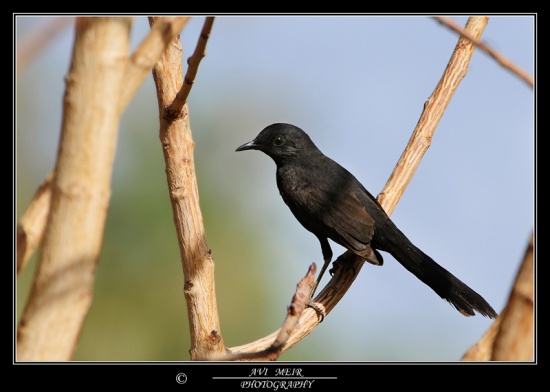m (Second image re-sized and re-positioned) |
m (→External Links) |
||
| (6 intermediate revisions by 2 users not shown) | |||
| Line 1: | Line 1: | ||
[[Image:Black_Bush_Robin.jpg|thumb|550px|right|Photo © by {{user|A.+Meir|A. Meir}}<br />Eilat, [[Israel]], March 2008]] | [[Image:Black_Bush_Robin.jpg|thumb|550px|right|Photo © by {{user|A.+Meir|A. Meir}}<br />Eilat, [[Israel]], March 2008]] | ||
| + | '''Alternative name: Black Bush Robin''' | ||
;[[:Category:Cercotrichas|Cercotrichas]] podobe | ;[[:Category:Cercotrichas|Cercotrichas]] podobe | ||
==Identification== | ==Identification== | ||
| Line 27: | Line 28: | ||
It is a rather active bird, and can be seen from early light until sometime after the sunset. It runs gracefully on the ground, keeping its balance by fanning its long tail up and down. | It is a rather active bird, and can be seen from early light until sometime after the sunset. It runs gracefully on the ground, keeping its balance by fanning its long tail up and down. | ||
====Breeding==== | ====Breeding==== | ||
| − | + | Breeding starts during January with the male displaying on the ground by cocking his tail, and sending his melodious song from a high branch in dry scrub. | |
The nest is usually near the ground; generally the pair incubates about 8 eggs at a time. | The nest is usually near the ground; generally the pair incubates about 8 eggs at a time. | ||
==References== | ==References== | ||
| − | #{{Ref- | + | #{{Ref-Clements6thOct22}}#Avibase |
| − | # | + | #Birdforum Member observations |
{{ref}} | {{ref}} | ||
==External Links== | ==External Links== | ||
| − | {{GSearch|Cercotrichas | + | {{GSearch|"Cercotrichas podobe" {{!}} "Black Scrub Robin" {{!}} "Black Bush Robin"}} |
| + | {{GS-checked}}1 | ||
| + | <br /> | ||
<br /> | <br /> | ||
| − | |||
| − | |||
| − | |||
| − | [[Category:Birds]][[Category:Cercotrichas | + | [[Category:Birds]][[Category:Cercotrichas]] |
Latest revision as of 22:41, 31 March 2023
Alternative name: Black Bush Robin
- Cercotrichas podobe
Identification
18–20 cm (7-7¾ in); tail about 12 cm
Glossy black plumage with dark brown feathers on the wings. Unmistakable long tail with white tips on the rear feathers obvious when looking from below.
Distribution
Africa and the Middle East
Western Africa: Mauritania, Senegal, The Gambia, Guinea-Bissau, Mali, Burkina Faso, Nigeria, Niger, Chad, Cameroon, Equatorial Guinea
Eastern Africa: Sudan, Eritrea, Ethiopia, Djibouti, Somalia
Middle East: Israel, Arabian Peninsula, Saudi Arabia, Yemen
Subspecies melanoptera is not a migrant, but makes annual movements as it can be seen in Asir (southern Saudi Arabia) in the months of May to August and in Jeddah and Yunbu (half way on the western cost of Saudi Arabia) from September until February; it has rare visits to south of Israel during the month of April.
Taxonomy
Subspecies
There are 2 subspecies[1]:
- C. p. podobe:
- C. p. melanoptera:
- Western Saudi Arabia, Yemen and Aden
Habitat
Dry savanna.
Behaviour
Diet
The bird spends most of his time searching the ground for insects.
Movement
It is a rather active bird, and can be seen from early light until sometime after the sunset. It runs gracefully on the ground, keeping its balance by fanning its long tail up and down.
Breeding
Breeding starts during January with the male displaying on the ground by cocking his tail, and sending his melodious song from a high branch in dry scrub.
The nest is usually near the ground; generally the pair incubates about 8 eggs at a time.
References
- Clements, J. F., T. S. Schulenberg, M. J. Iliff, T. A. Fredericks, J. A. Gerbracht, D. Lepage, S. M. Billerman, B. L. Sullivan, and C. L. Wood. 2022. The eBird/Clements checklist of Birds of the World: v2022. Downloaded from https://www.birds.cornell.edu/clementschecklist/download/
- Avibase
- Birdforum Member observations
Recommended Citation
- BirdForum Opus contributors. (2024) Black Scrub Robin. In: BirdForum, the forum for wild birds and birding. Retrieved 18 May 2024 from https://www.birdforum.net/opus/Black_Scrub_Robin
External Links
GSearch checked for 2020 platform.1





